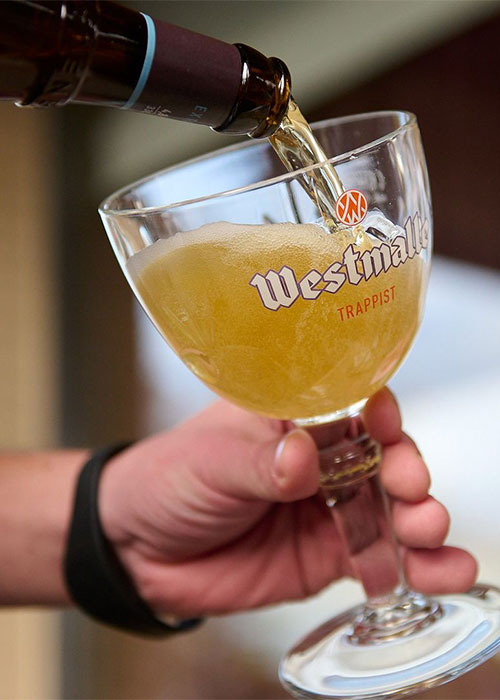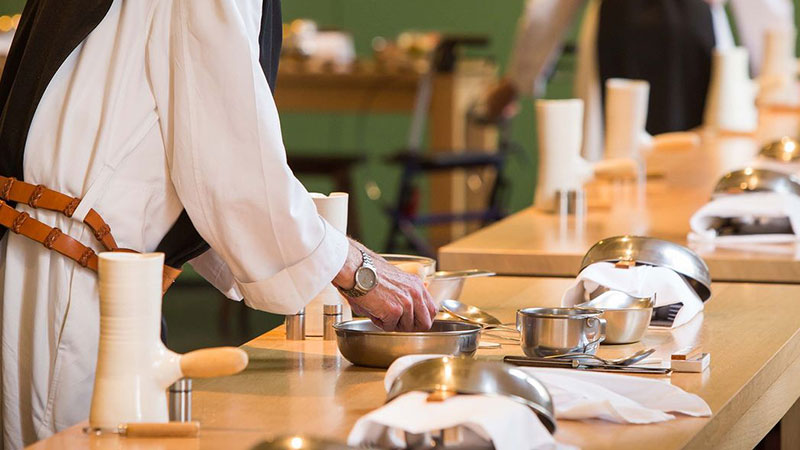In September I received a PR email that actually surprised me.
Westmalle, the brewery run by Trappist monks since 1836, was set to release a new beer to the U.S. market. For nearly 100 years, they had only sold two beers: Westmalle Dubbel, a ruby red, malty strong ale, and Westmalle Tripel, a glowing orange, slightly herbal ale that literally invented the style. But now, in the year 2022, at the tail end of a pandemic, in one of the most challenging, competitive beer markets ever, the monks were ready to release a new beer.
Called Westmalle Extra, it was golden-colored, slightly fruity, and way lower in ABV (4.8 percent) than their iconic Dubbel and Tripel; it was said to be the same beer the monks consume during meals and had, heretofore, never been made available to the public.
Don’t Miss A Drop
Get the latest in beer, wine, and cocktail culture sent straight to your inbox.
No, it wasn’t a hazy IPA or a fruited sour or some pastry stout loaded with coconut and Madagascar vanilla beans. But the mere fact a Trappist brewery was doing something new, anything new, made me take note.
Were the Trappist monks finally preparing to take on our modern beer age?
The ITA Is It
Trappist monasteries have formally existed since the 17th century after branching off from the Cistercians. In starting this new religious order, they decided to live by a tenet of following a self-supporting existence. So they would make their textiles, do woodwork, farm, produce cheese and preserves; they soon began brewing beer for their own purposes and those of the local community. (Other non-Trappist monasteries had been brewing beer even earlier than this.)
Abdij Onze-Lieve-Vrouw van het Heilig Hart van Jezus was founded in 1794 and by 1836 was the Trappist abbey in Westmalle. Later that year, Father Bonaventura Hermans and Albericus Kemps began brewing beer, and by 1856 Brouwerij der Trappisten van Westmalle had produced their first strong, dark ale, a progenitor of what would become a sort of Trappist style if there is one. That same year, they began to sell their beer locally, and by 1921 the beer was being distributed.
In 1978, Merchant du Vin was founded in Seattle, Wash., and began importing beer from Westmalle and several other Belgian Trappist breweries like Brasserie de Rochefort and Brasserie d’Orval to the United States. Starting in 1997, these breweries would officially be codified as part of the International Trappist Association (ITA) along with three additional Belgian monk-run breweries: Brouwerij Westvleteren (St Sixtus), Bières de Chimay, and Achel; and one from the Netherlands, Brouwerij de Koningshoeven (La Trappe).
If there were less than a dozen craft breweries when Merchant du Vin launched in 1978, by 1997 there were around 400, with about 900 additional brewpubs. The craft beer boom had been ignited and people were drawn to the sorts of robust, flavorful, and often boozy beers that the Trappists offered.

Moving to Manhattan in 2001, straight out of college, I found the biggest city in America mostly lacked any sort of craft brewery scene. But there was a ton of Trappist beer being imported, sold at grocery stores and even bodegas, and available at classier bars and restaurants. I quickly fell for the dubbels and tripels of Westmalle, the even more intense dark ales of Rochefort, and the slightly funky Orval. There was nothing else like them around.
Other nascent craft beer drinkers clearly were falling for Trappist beer, too. By 2001, Beer Advocate magazine had begun listing its Top Beers overall and, in their initial Top 20, two Trappist beers would appear: Rochefort 10 at No. 6 and Chimary Première (Red Label) at No. 10. Another six Belgian or Belgian-inspired beers would also make the Top 20.
By 2005, the site’s No.1 beer in the world was Westvleteren XII, a quadruple from the only Trappist brewery not distributed to America. (To a certain extent, this early passion for “Westy” would predict a future of rarity, #linelife, and hype culture in American beer.) Additionally, you had Westvleteren VIII at No. 4, Rochefort 10 at No. 12, Rochefort 8 at No. 50, and Westmalle Tripel at No. 97.
Westvleteren XII would remain No. 1 until 2012, when the Saint-Sixtus Abbey, in need of cash flow for some monastery renovations, released 90,000 bottles into the U.S. No longer rare, the beer almost instantly fell out of the top 10.
Little did most people realize, but the glory days of Trappist beer in the U.S. were all but over.
Current With a Contemporary World
Today there are some 10,000 American breweries, and the styles that drive excitement remain hazy IPAs, pastry stouts, and fruited sours — that’s what dominates the current Beer Advocate Top 250.
So how do these century-old Trappist breweries obstinately making styles lacking in de rigueur hops, absent of dessert-y adjunct or fruits, and often not even written in English manage to compete?
“It’s not about trying to stay on top of market trends or create something new and sparkling and shining,” says Jhon Gilroy, who has worked for Merchant du Vin for the last 16 years, after a previous stint at Portland craft brewer McMenamins. “Having said that, the Trappist [monks], though they’re cloistered and their life is centered around quiet contemplation, doing the work that they do for everyone’s soul and spirit, they want to be connected and current with a contemporary world.”
Which is to say that the monks are more than aware of beer trends in the States, says Gilroy. But you’re probably never going to see a Westmalle Hazy or a Chimay Pastry Stout.
Unlike those 10,000 breweries in America, the Trappist breweries are non-profit entities. Most only even run the bottling line one day a week because it’s noisy and makes quiet contemplation very difficult. And if they don’t sell all their beer, it’s not the end of the world so long as they can still be monks.

“They only use beer as the means to support themselves and do their charitable works,” says Gilroy.
To a certain extent, in this increasingly secular age, Trappist monasteries and monks themselves are dwindling. (In 2021, the former Trappist brewery Achel lost their ITA designation as they had run out of monks.)
But even so, there is some innovation going on in the Trappist scene, notably with La Trappe of the Netherlands. Unlike their Belgian brethren, and very much like many American breweries, they are not afraid to throw their beers into any sort of crazy barrel they can find. Recently that has meant everything from Laphroaig single malt barrels and Caribbean rum casks to Calvados barriques.
“The monks are really aware of what’s happening out there,” says Christa van der Laan Trade of Swinkels Family Brewers, La Trappe’s distributor. “Trappists are known for quite heavy beers. In 2020 they said, ‘We really need an alcohol-free beer if we want to grow with the world.’”
That would be La Trappe Nillis, the only N/A beer ever released from a Trappist brewery. In 2021, they did collaborations with winery Château de l’Horte as well as one with the much-maligned BrewDog.
“At first [the monks] said, ‘Hmm… we don’t know if it’s the perfect fit,” says van der Laan. But the monks changed their minds when BrewDog agreed to donate a portion of sales of Practise What You Preach, a Belgian Quadrupel made with Scottish Heather Honey and American hops, to clean water initiatives, something very important to the head of the monastery, Father Abbot.
There are even new Trappist breweries hitting the scene, now totaling 11. The last decade has seen the introduction of Zundert in the Netherlands, Tre Fontane Abbey in Italy, and Tynt Meadow in England, Merchant du Vin’s latest brewery to introduce to America.
The Monkster Mash
Right around the release of Westmalle Extra, there was some other big Trappist brewery news. Spencer Brewery at St. Joseph’s Abbey, the only American Trappist brewery, announced they were closing.
“After more than a year of consultation and reflection, the monks of St. Joseph’s Abbey have come to the sad conclusion that brewing is not a viable industry for us and that it is time to close,” the brewery announced.
Located on a pastoral 2,000-acre property in Spencer, Mass., it was a uniquely American Trappist brewery. Launched in 2014 with a Belgian-style golden ale that was quite good, St. Joseph’s soon shifted to making more of-the-moment American styles you find at nearby craft beer darlings like Tree House or Stone Cow.
Spencer released a grapefruit IPA with Citra hops, a peach saison, an imperial stout aged in Weller bourbon barrels, German-style pilsners and Oktoberfests, and even a canned pumpkin beer regrettably named The Monkster Mash. In a post-mortem, William Dingwall, Spencer Brewery’s director, admitted this trend-chasing was way too “reactionary.”
That’s perhaps why it’s so interesting that Spencer is seemingly the only Trappist brewery that has failed.
Trappist breweries aren’t supposed to be reactionary, they aren’t supposed to be trendy. They aren’t supposed to pivot to pounder cans because that’s what hazebois want. And they certainly don’t need to release a hard seltzer line for an easy cash grab. They just need to be true to themselves and their missions. It’s an ethos a lot of secular craft breweries might be smart to remember themselves.
“These monasteries have been through two world wars, plagues, pestilence, revolutions, and had governments after them,” says Gilroy. “If anyone’s in a good position to survive, these are the folks that are going to do that.”
This story is a part of VP Pro, our free content platform and newsletter for the drinks industry, covering wine, beer, and liquor — and beyond. Sign up for VP Pro now!